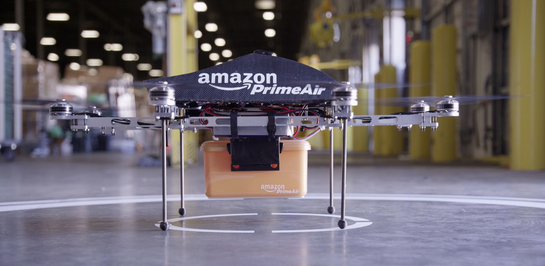![Delivery drones like these may soon become a reality. [Amazon]](http://www.jstudentboard.com/reporter/wp-content/uploads/2015/04/Screen-Shot-2015-04-29-at-2.39.42-PM.png)
The Federal Aviation Administration (FAA), the national aviation authority in the US, issued an experimental airworthiness certificate on March 19 to Amazon.com to allow the company to to start testing delivery drones for Amazon Prime Air. This experimental delivery system would allow customers to have their purchases delivered to them via drone if they meet certain criteria.
The certificate came after a year and a half of pressure by Amazon, which threatened to move all of its drone research out of the US if Congress did not act quickly. Because the FAA currently classifies drones under the framework for manned aviation, this severely limits how they can used in the US. While waiting for progress, Amazon had moved overseas to Cambridge, England because the European Aviation Safety Agency (EASA) is more lenient in drone use and recently proposed a new policy framework that treats drones as their own category of aircraft.
Yet, the granting of the certificates has come with some problems. The FAA has insisted that the drones remain within line of sight of the pilot at all times. In Amazon’s case, pilots must also have “at least a private pilot’s certificate and current medical certification.” Though critics of the policy say these restrictions make sense for initial testing, they point out that they will definitely prevent any notable commercial operation if they remain in place because they severely limit drone use over any significant distance and add more cost to the program.
Not surprisingly, Amazon has voiced its disapproval over these restrictions. A mere five days after the granting of the certificate Amazon vice president for Global Public Policy Paul Misener told a Senate subcommittee that, while the FAA was considering the applications for testing, Amazon had innovated so rapidly that the drone approved by the FAA has become “obsolete” and that the company had “moved on to more advanced designs that already are [being] testing abroad.”
“Nowhere outside of the United States,” stated Misener, “have we been required to wait more than one or two months to begin testing, and [in other countries] permission has been granted for operating a category of Unmanned Aircraft Systems (UAS), giving us room to experiment and rapidly perfect designs without being required to continually obtain new approvals for specific UAS vehicles.”
However, Crescenta Valley High School (CVHS) robotics team member Tony Kim, a drone aficionado in his spare time, believes that although Amazon Prime Air has “potential,” it is not viable as a business model.
“Having flown drones myself,” said Kim to JSR, “I know how hard it is to code the thing, and just one little mistake can mean that you lose everything on the drone and have to start over. If it cost me $500 to replace a broken motor on my drone, imagine how much their repair bills will be.”
Kim added, “The ones that I have right now only have 15 minutes of battery life and are very hard to fly. Their drones probably have more battery life than mine, but the flying part would probably be the same, if not more so due to size and the fact they they have to carry a package.”
Ultimately,” he continued, “there’s so many things that can go wrong with the whole program that Amazon probably has to prepare for every single little thing, and the little costs are most likely going to keep adding up until it is no longer profitable.”
However, Kim wishes Amazon good luck with the program.
“Who knows what will happen in five or ten years,” he concluded. “Maybe Amazon will get lucky and my new personal drone will one day come to me by an Amazon drone.”

